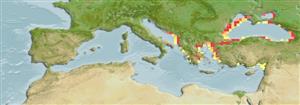分類 / Names
共通名の | 類義語 | Catalog of Fishes(部類, 種) | ITIS | CoL | WoRMS | Cloffa
Environment: milieu / climate zone / depth range / distribution range
生態学
海; 新鮮な水; 汽水性の; 昇流魚 (Ref. 51243); 深さの範囲 70 - 180 m. Temperate; 10°C - 20°C (Ref. 2059); 57°N - 35°N, 13°E - 60°E
Eurasia: Caspian, Black, Azov and Adriatic Sea basins.
Extirpated from Adriatic Sea.
Length at first maturity / サイズ / 重さ / 年齢
Maturity: Lm ?, range 200 - ? cm
Max length : 800 cm TL オス/雌雄の選別がない; (Ref. 59043); common length : 215 cm TL オス/雌雄の選別がない; (Ref. 3397); 最大公表体重: 3.2 t (Ref. 59043); 最大記録サイズ: 118 年 (Ref. 47437)
背面の脊椎 (合計) : 0; 背鰭 (合計) : 62 - 73; 肛門の骨: 0; 臀鰭: 28 - 41. Snout moderate and pointed, turning slightly upward. Lower lip not continuous, interrupted at center. Barbels oval or flat, leaf-like posteriorly, reaching almost to mouth. Five rows of scutes, dorsal 11-14 (first one smallest), lateral 41-52 on each side, ventral 9-11 on each side. Back ash-grey or greenish, flanks lighter, belly white.
Pelagic at the sea, following its prey. Undertakes upriver migration to spawn. Juveniles occur in shallow riverine habitats during their first summer. Spawns in the main course of large and deep rivers with strong current and on stone or gravel bottom (Ref. 59043). Feeds mostly on sea fishes (Black Sea whiting, anchovies, flatfishes, gobies, fry of bottom-living fishes), also crustaceans, mollusks, mysids and amphipods. Fisheries are based almost entirely on the value of the caviar, but meat also is sold fresh, smoked and frozen; eaten broiled, boiled, fried and baked (Ref. 9988). Bester, a hybrid of female Huso huso and male sterlet Acipenser ruthenus, has been successfully cultivated for its high quality eggs (Ref. 9988). The largest sturgeon and largest European freshwater fish. In Guinness Book of Records as the most expensive fish (Ref. 6472). Threatened due to overfishing for meat at the sea and for caviar in estuaries. These threats will soon cause global extinction of the natural populations. Survival can only depend on stocking (Ref. 59043).
Enters rivers from March, usually April and May (also in autumn). Survives largely by artificial propagation. About 360,000-7,700,000 eggs per female. Females carry eggs only once every five to seven years (Ref. 9988).
Kottelat, M. and J. Freyhof, 2007. Handbook of European freshwater fishes. Publications Kottelat, Cornol and Freyhof, Berlin. 646 pp. (Ref. 59043)
Human uses
水産業: 商業; 水産養殖: 商業
用具
特記事項
XMLをダウンロードして下さい
インターネットの情報源
Estimates based on models
Preferred temperature (Ref.
123201): 7.7 - 15.6, mean 9.1 °C (based on 19 cells).
Phylogenetic diversity index (Ref.
82804): PD
50 = 0.7500 [Uniqueness, from 0.5 = low to 2.0 = high].
Bayesian length-weight: a=0.00447 (0.00269 - 0.00740), b=3.11 (2.97 - 3.25), in cm total length, based on LWR estimates for this species & (Sub)family-body (Ref.
93245).
栄養段階 (Ref.
69278): 4.4 ±0.3 se; based on diet studies.
回復力 (Ref.
120179): 非常に低い, 14年以上の倍増期間の最小個体群 (K=0.1; tm=13-22; tmax=118; Fec=360,000).
Fishing Vulnerability (Ref.
59153): Very high vulnerability (89 of 100).
Climate Vulnerability (Ref.
125649): Very high vulnerability (79 of 100).
Nutrients (Ref.
124155): Calcium = 6 [3, 12] mg/100g; Iron = 0.234 [0.128, 0.408] mg/100g; Protein = 17.9 [15.5, 20.5] %; Omega3 = 0.34 [0.15, 0.73] g/100g; Selenium = 27.1 [11.7, 60.4] μg/100g; VitaminA = 5.85 [1.52, 24.89] μg/100g; Zinc = 0.331 [0.221, 0.505] mg/100g (wet weight); based on
nutrient studies.
